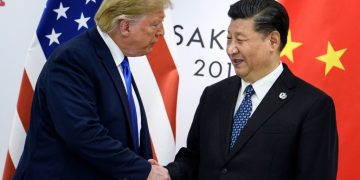October 27, 2025 — In a major development for global trade, the United States and China reached a preliminary framework agreement, paving the way for a high-profile summit between President Donald Trump and Chinese President Xi Jinping. The announcement came during Trump’s Asia tour, which included stops in Malaysia and other Southeast Asian nations. The deal aims to prevent the imposition of steep tariffs that threatened global markets and supply chains. Analysts suggest this framework could mark a turning point in the often-contentious U.S.-China trade relationship. (Sources: Reuters, The Guardian)
Framework Agreement Details
The framework highlights several areas of cooperation and compromise. Key elements include:
Sale of TikTok’s U.S. Operations
China has agreed to allow the sale of TikTok’s U.S. operations to American investors. This addresses longstanding national security concerns and satisfies U.S. calls for domestic control over sensitive data platforms. Analysts say this step removes a major point of tension between the two nations.
Rare Earth Minerals
China will postpone export controls on rare earth minerals for one year. These minerals are crucial for industries such as electric vehicles, renewable energy, and defense applications. The delay provides U.S. manufacturers with supply certainty and reduces the risk of shortages that could disrupt production globally.
Tariff Avoidance
The deal prevents the scheduled 100% tariffs on Chinese imports, originally set for November 1. By averting these punitive measures, both countries aim to stabilize trade flows and reduce costs for businesses and consumers.
Regulatory and Investment Cooperation
The framework also emphasizes collaboration on regulatory standards, intellectual property protections, and foreign investment. Both nations committed to creating a predictable business environment that encourages innovation and cross-border commerce.
Treasury Secretary Scott Bessent described the framework as “an important step toward a comprehensive trade resolution,” noting that the agreement balances compromise with the protection of national economic interests.
Trump’s Optimism Ahead of Xi Summit
President Trump expressed confidence in the framework’s prospects. Speaking from Kuala Lumpur, Malaysia, where he attended the ASEAN-U.S. Summit, he called the deal “a fantastic opportunity” for both nations. Trump emphasized that the framework demonstrates progress after years of trade tension.
“This is not just about tariffs; this is about fairness, opportunity, and cooperation. We are creating a path that benefits American workers, companies, and strategic interests,” he said.
The Trump-Xi summit, scheduled in Busan, South Korea, will focus on formalizing the framework and discussing implementation measures. Observers note that the timing is critical, as global markets remain sensitive to trade disputes.
Reactions from Business and Industry Leaders
The framework has been welcomed by global businesses. Manufacturers dependent on Chinese imports, particularly in technology and automotive sectors, have faced rising costs due to tariff threats and supply chain disruptions.
“We’ve been closely monitoring these developments, and the framework agreement is a positive signal,” said Karen Liu, a trade analyst at the Global Trade Institute. “Companies can now plan for inventory, production, and investment decisions with more confidence.”
Chinese industry groups expressed cautious optimism. By agreeing to the TikTok sale and postponing rare earth restrictions, China signals willingness to address foreign concerns while retaining strategic control over key industries.
Regional and Global Implications
The framework deal has implications far beyond the U.S. and China.
Impact on Southeast Asia
Trump’s engagement in Southeast Asia, including trade agreements with Malaysia and Cambodia, suggests that reduced U.S.-China tensions could enhance regional economic stability and growth.
Global High-Tech Industries
The postponement of rare earth mineral restrictions affects global technology sectors. These minerals are essential for high-tech products worldwide, including electric vehicles, consumer electronics, and defense systems. Analysts say uninterrupted supply chains will prevent price spikes and support innovation.
Financial Markets Reaction
Markets responded positively. U.S. stock futures rose, especially in technology and manufacturing sectors, while Asian equities showed modest gains. Currency markets stabilized, with the U.S. dollar regaining steadiness against the Chinese yuan after weeks of volatility.
Challenges and Remaining Issues
Experts caution that the framework is only a preliminary step.
Implementation Concerns
Negotiations will need to address details such as timelines, enforcement mechanisms, and compliance monitoring.
Intellectual Property and Technology Transfer
These remain sensitive areas. While the framework signals cooperation, adherence by companies in both countries will require ongoing oversight.
Political and Public Perception
Domestic audiences in both nations may pressure leaders for more concrete concessions. U.S. lawmakers argue that the framework may not fully address long-term trade imbalances, while Chinese officials are cautious about appearing to concede too much.
Potential Benefits of a Successful Deal
If fully implemented, the framework could yield several benefits:
- Stabilized Trade Flows: Avoiding tariffs will prevent sudden disruptions in supply chains and reduce costs for businesses and consumers.
- Investment Certainty: Confidence in market stability may boost cross-border capital flows and partnerships.
- Technological Collaboration: Cooperation on rare earth minerals and regulatory standards could support innovation in high-tech industries.
- Regional Confidence: Southeast Asian economies closely linked to both powers could see improved trade prospects and economic growth.
Looking Ahead to the Trump-Xi Summit
The Busan summit is expected to be decisive. Observers will monitor whether both leaders formalize the framework and commit to concrete timelines.
Trade analysts suggest that a successful summit could provide a blueprint for resolving other contentious issues, such as cybersecurity, intellectual property disputes, and market access.
“The stakes are high,” said Peter Huang, an international trade consultant. “This framework signals progress, but real impact depends on follow-through, monitoring, and trust between governments and businesses.”
Conclusion
The preliminary trade framework between the United States and China marks a major milestone in a long negotiation process. By averting tariffs, addressing TikTok ownership, and postponing rare earth restrictions, both nations signal a willingness to engage constructively.
President Trump’s optimism ahead of the summit reflects a strategic push to stabilize trade relations and strengthen economic ties. The Busan meeting’s outcome will influence U.S.-China relations, global trade, investment flows, and regional economic confidence.
For businesses, investors, and governments worldwide, the framework provides cautious optimism: dialogue, compromise, and strategic engagement can avert trade crises and foster international cooperation in a complex global economy.












